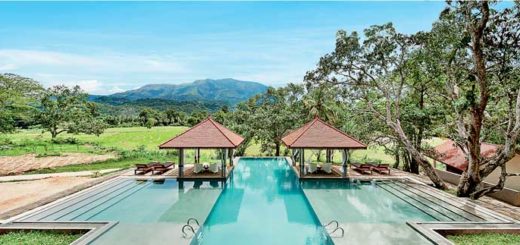Southern Escape: A Visit to Galle, Mirissa & Uda Walawe
by Jetwing · Published · Updated
We have decided to take a break from Colombo and head south with my mum for a few days. She has organised a Jetwing Tailor-Made holiday for us with Sriyantha, the Manager with whom we have dealt with on previous occasions. Being able to design your own itinerary together with Jetwing is ideal for someone like me who doesn’t want to be just a passenger on a tour group. See their website for more details – http://www.srilankatailormade.com/why-tailormade/
A tailor made tour enables you to venture outside the beaten path if you wish, giving the traveller a unique taste of what this Island has to offer.
We have a new guide this year and his name is Mallick. He helps us load our bags into the spacious van we have hired and we are on our way. On my bucket list is a wish to see some whales in the wild and the stilt fisherman of Weligama. I feel excited…
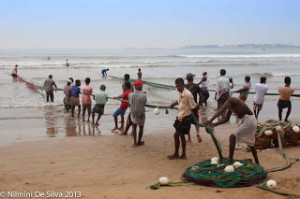 We are taking the new Southern Expressway for the first time and arrive in Galle in record time. We have got lucky and stumble across a community of fisherman hauling in their nets. The scene is a hive of activity and the sound of their singing fills the air. “Hodi Hellai, Hellai ya”, the fisherman chant as they pull the nets in, both to lighten the task at hand as well as to maintain their rhythm. It is a lot of work but when the net is finally brought ashore, there is only a small catch to reward them for their efforts.
We are taking the new Southern Expressway for the first time and arrive in Galle in record time. We have got lucky and stumble across a community of fisherman hauling in their nets. The scene is a hive of activity and the sound of their singing fills the air. “Hodi Hellai, Hellai ya”, the fisherman chant as they pull the nets in, both to lighten the task at hand as well as to maintain their rhythm. It is a lot of work but when the net is finally brought ashore, there is only a small catch to reward them for their efforts. 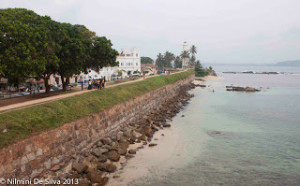 Fishing in this manner is very much a communal affair. Volunteers always materialise whenever a net needs to be hauled in. Depending on the catch, the fishermen employed by the net owner will distribute part of the catch. Today, they may go away with nothing.
Fishing in this manner is very much a communal affair. Volunteers always materialise whenever a net needs to be hauled in. Depending on the catch, the fishermen employed by the net owner will distribute part of the catch. Today, they may go away with nothing.
We stop at the Galle Fort to take in the view. Before long we are approached by one of the Galle Fort jumper who dives into the ocean from the ramparts for about $20 dollars. I look down at the rocks and feel nervous for him and a little hesitant to support a practice that might prove to be a dangerous pastime. 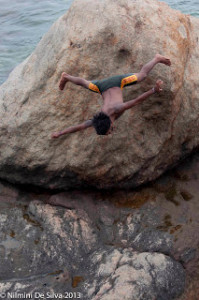 He convinces me that this is what he does everyday, he knows what he is doing and he needs the money to support his family. There are seven jumpers and they take it in turns to make the leap and business is slow. I reluctantly agree and watch in amazement at his agility and his antics.
He convinces me that this is what he does everyday, he knows what he is doing and he needs the money to support his family. There are seven jumpers and they take it in turns to make the leap and business is slow. I reluctantly agree and watch in amazement at his agility and his antics.
We enjoy a drive through the fort before Mallick parks the van and says we should walk around the fort to get a better sense of this place. It was the Portuguese who initially came here in 1505. When they eventually moved here in the late fifteen hundreds, they constructed a rampart to defend the city. When the Dutch colonised Sri Lanka, they rebuilt the fort with a stone defence wall to render it impenetrable against the English, French, Danish, Spanish and Portuguese fleets vying with Holland for the supremacy of the seas.
It feels much calmer to be inside the fort, than to be on the outside. The narrow streets lend a more intimate feel to the place and we stop to browse the local shops. There are also a couple of historic churches, mosques and other beautiful buildings including a museum within the walls. The fort was eventually taken over by the British and is one of the best examples of a European fortified city in this part of the world. Today, many artist and foreign visitors spend time here. It would be a great spot to write if not for the fact the heat and humidity in the middle of the afternoon felt stifling!
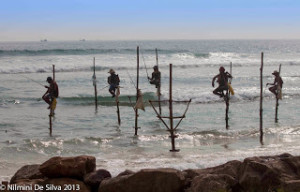 We leave Galle for Mirissa, where we will stay for 3 days. On the way we stop to watch some stilt fisherman perched on their ‘fishing sticks’. Sri Lanka is the only place in the world where you will see stilt fishing although it appears to be a dying art. Sitting on a rather unsteady stick for hours on end in the hope of catching a few fish that will bring a few dollars is no easy task. These days they hope the travellers passing by will not only take photos they will make contribution to putting some rice on the table. I got the photos I wanted but it didn’t feel like a truly authentic experience due to the commercial nature that now exists.
We leave Galle for Mirissa, where we will stay for 3 days. On the way we stop to watch some stilt fisherman perched on their ‘fishing sticks’. Sri Lanka is the only place in the world where you will see stilt fishing although it appears to be a dying art. Sitting on a rather unsteady stick for hours on end in the hope of catching a few fish that will bring a few dollars is no easy task. These days they hope the travellers passing by will not only take photos they will make contribution to putting some rice on the table. I got the photos I wanted but it didn’t feel like a truly authentic experience due to the commercial nature that now exists.
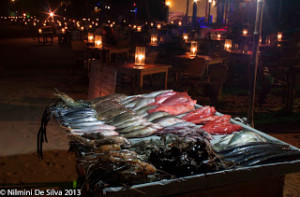 Our resort at Mirissa was just what the doctor ordered. We checked into a family suite and enjoyed going for a dip in the ocean. The waves were crashing quite ferociously and we were buffeted and pummelled a fair bit but it was an exhilarating experience and a great way to relax. We were also in for a delightful surprise for dinner when the resort staff moved the tables onto the beach, lighting candles and creating a wonderful atmosphere. Tables laden with the days catch were then setup together with a BBQ on which our dinner was cooked. It was a wonderful start to our southern escape.
Our resort at Mirissa was just what the doctor ordered. We checked into a family suite and enjoyed going for a dip in the ocean. The waves were crashing quite ferociously and we were buffeted and pummelled a fair bit but it was an exhilarating experience and a great way to relax. We were also in for a delightful surprise for dinner when the resort staff moved the tables onto the beach, lighting candles and creating a wonderful atmosphere. Tables laden with the days catch were then setup together with a BBQ on which our dinner was cooked. It was a wonderful start to our southern escape.
Day two was spent whale watching. The south coast of Sri Lanka is one of the best places in the world to watch whales. From blue whales and sperm whales to spinner dolphins, the ocean is teeming with life. Many of my friends have reported seeing hundreds of dolphins but at first we didn’t really see much of anything. After hours out at sea, we decided to head back to shore but luck was ultimately on our side. 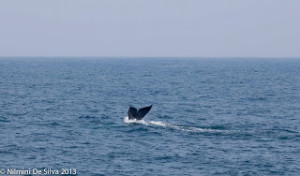 A shout from one of the boatman and we’ve turned the boat and start heading back just in time to see two incredible blue whales break the surface and blow air through the blow hole at the top of their heads. It was the first sign of more exciting things to come. We gasp as we see their massive bodies immerge just before they vanish into the depths of the ocean with their tails up in the air. The largest of the whales they can grow to be approximately 30 m long and equivalent to the weight of 50 elephants. We see this scene repeated twice before we head back to base for a second time.
A shout from one of the boatman and we’ve turned the boat and start heading back just in time to see two incredible blue whales break the surface and blow air through the blow hole at the top of their heads. It was the first sign of more exciting things to come. We gasp as we see their massive bodies immerge just before they vanish into the depths of the ocean with their tails up in the air. The largest of the whales they can grow to be approximately 30 m long and equivalent to the weight of 50 elephants. We see this scene repeated twice before we head back to base for a second time.
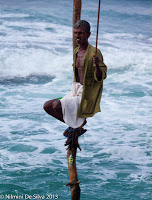 We drive back to Galle on Day 3, stopping once again to see some of the stilt fisherman on the way. Our first stop is the turtle hatchery where we learn a little about these species. Sri Lanka is home to 5 of the world’s 7 species of turtles. They come ashore to lay their eggs but unfortunately, many of these eggs are poached and sold for about AUD$0.25 each. The staff at the hatchery, together with volunteers work to recover these eggs and re-bury them in a safe place, giving these turtles a chance at life. Only fresh eggs can be eaten so if the eggs are saved in the first 24 hours of being laid, the turtles have a chance of being born.
We drive back to Galle on Day 3, stopping once again to see some of the stilt fisherman on the way. Our first stop is the turtle hatchery where we learn a little about these species. Sri Lanka is home to 5 of the world’s 7 species of turtles. They come ashore to lay their eggs but unfortunately, many of these eggs are poached and sold for about AUD$0.25 each. The staff at the hatchery, together with volunteers work to recover these eggs and re-bury them in a safe place, giving these turtles a chance at life. Only fresh eggs can be eaten so if the eggs are saved in the first 24 hours of being laid, the turtles have a chance of being born.
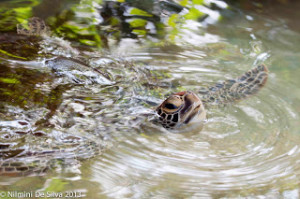 the wild and if they survive, they will return to this beach to lay their own eggs one day. The project we visited also takes care of wounded turtles as well and release them when are strong enough to survive alone in the wild. Such programs are wonderful but underfunded in a country where a lot more funding is required for conservation.
the wild and if they survive, they will return to this beach to lay their own eggs one day. The project we visited also takes care of wounded turtles as well and release them when are strong enough to survive alone in the wild. Such programs are wonderful but underfunded in a country where a lot more funding is required for conservation.
We also visited the folk museum complex in Koggala, which includes the house that the famous Sri Lankan author Martin Wickramasinghe lived in for many years. The grounds are peaceful and green and we really enjoyed browsing through lots of memorabilia from yesteryear.
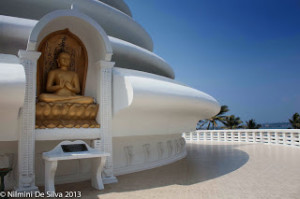 We also visited the Japanese Peace Pagoda – a wonderful place to meditate if you were so inclined. Beautiful views of the ocean and coconut palms swaying in the breeze remind you where you are. It was lunchtime and we decide to check out the luxurious Jetwing Lighthouse Hotel for lunch. The creation of Sri Lanka’s renowned architect Geoffrey Bawa, it is a beautifully crafted hotel. We loved the minimalistic, rustic nature of the place with its wide-open verandas that afforded beautiful views of the ocean and let the sea breezes in.
We also visited the Japanese Peace Pagoda – a wonderful place to meditate if you were so inclined. Beautiful views of the ocean and coconut palms swaying in the breeze remind you where you are. It was lunchtime and we decide to check out the luxurious Jetwing Lighthouse Hotel for lunch. The creation of Sri Lanka’s renowned architect Geoffrey Bawa, it is a beautifully crafted hotel. We loved the minimalistic, rustic nature of the place with its wide-open verandas that afforded beautiful views of the ocean and let the sea breezes in.
We head back for our last ocean dip and candle lit dinner on the beach. On the way back we detour to Weligama to discover the monument and church honouring the first Methodist missionaries who were shipwrecked here 200 years ago. That night, over margaritas and seafood we say goodbye to a wonderfully relaxing stay at Mirissa Bay Resort.
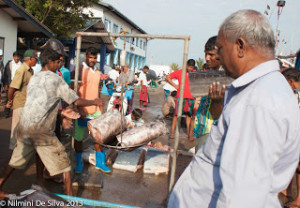 We check out on Day 4 to head to Uda Walawe. Our first stop had been the Mirissa Fish Market where we had enjoyed the hustle and bustle of a fish auction. We had been amazed to learn the deep sea fisherman stay out at sea for 2 months before coming back to shore with their catch. The scene was chaotic and colourful and I could have stayed here much longer than the short visit our schedule permitted.
We check out on Day 4 to head to Uda Walawe. Our first stop had been the Mirissa Fish Market where we had enjoyed the hustle and bustle of a fish auction. We had been amazed to learn the deep sea fisherman stay out at sea for 2 months before coming back to shore with their catch. The scene was chaotic and colourful and I could have stayed here much longer than the short visit our schedule permitted.
We visit a couple of temples on the way. The first of these was the Devundara (meaning City of Gods) Temple, located in Dondra, the southern most point of the island. A Buddhist Devalaya dedicated to god Vishnu attracts both Hindu and Buddhist devotees who were engaged in various acts of devotion. From lighting oil lamps, to smashing coconuts and taking baskets of fruit and flowers to offer to the Buddha, it was a busy place. 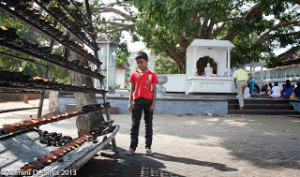 The other temple we visited was the Weerahena Temple, distinct because of the massive Buddha statue at the entrance and the underground paintings and cartoons coverings the walls. It was an interesting temple to visit and the views from the back of the Buddha quite stunning.
The other temple we visited was the Weerahena Temple, distinct because of the massive Buddha statue at the entrance and the underground paintings and cartoons coverings the walls. It was an interesting temple to visit and the views from the back of the Buddha quite stunning.
The highlight of Day 4 was our visit to Uda Walawe. We first checked into our accommodation at the Thuduwa Camp where we left our bags and my mum at the rustic chalets that will be home for the night. The grounds are well designed and the chalets that look like they belong more in a remote Sri Lankan village reveal quite comfortable beds and washroom when you peeked inside. 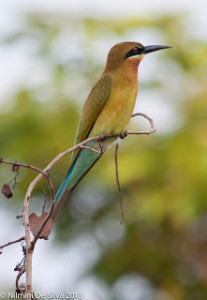
We drove to the Uda Walawe National Park where we exchanged our van for a 4-wheel drive jeep and setoff on our safari. We were rewarded right away by a sighting of two elephants right by the roadside, quite unperturbed by our jeep only a few feet away. 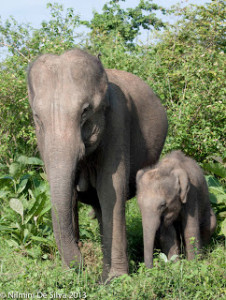 As the afternoon wore on we spotted some rare birds, more elephants, mating peacocks, and a few crocs. It was a great experience and we headed back to camp having come to the end of our fabulous getaway!
As the afternoon wore on we spotted some rare birds, more elephants, mating peacocks, and a few crocs. It was a great experience and we headed back to camp having come to the end of our fabulous getaway!
By Nilmini De Silva


